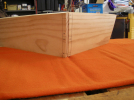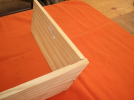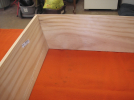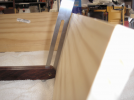I'm waiting on a delivery today so I have time to write this up. Now is where we set up the pieces to compensate for the compound angle.
Starting on the inside of the pieces, set up a marking gauge to a depth that will give the assembled joint some overhang to be planed off after assembly.
With inside of the pieces marked we can now use a square and marking knife to transfer the the baseline to the outside of the boards.
As you can see the ends are square in relationship with the surface of the board, and the base line is square in relationship with the bevel angle of the board.
Now you adjust the marking gauge to meet the knife lines and scribe a line on the outside.
We are now to the point that we can set up for the dovetails. We can't use a typical dovetail marker, we could just layout what we think looks good, and that would be fine, however, if you have an angle in mind the process I used is as follows.
You start by setting up a bevel gauge to the angle of the end of the board and use it to mark a line parallel to the top and bottom.
Take a pair of dividers and set them to approximately an inch.
Set the dividers on the center line and mark on the edge on both sides of the line.
For this example I chose to use a one and five ratio for these dovetails. Take the dividers and step off five times on the center line and mark you finishing point. Now take and connect the points you marked with the dividers.
That's all I have time for this morning I'll post more this evening.
Later!





